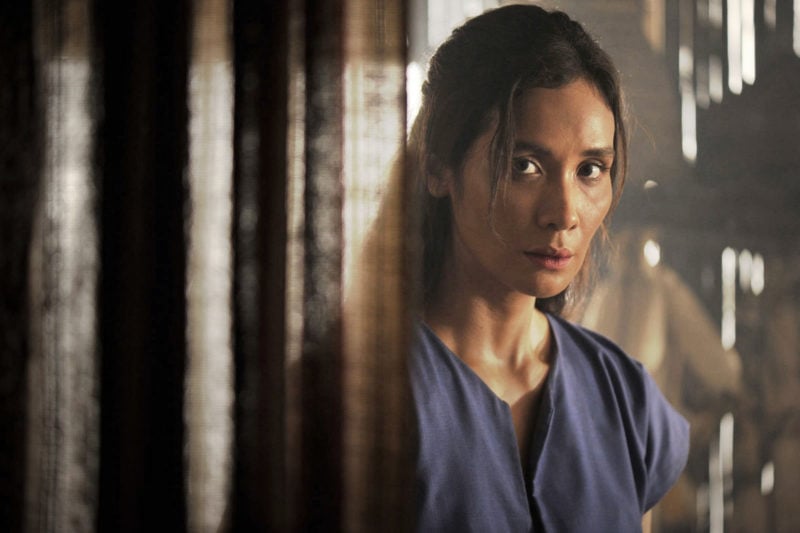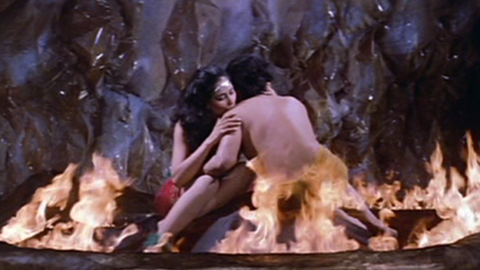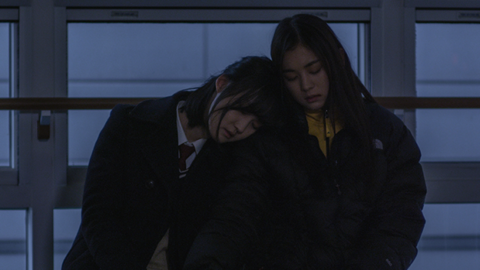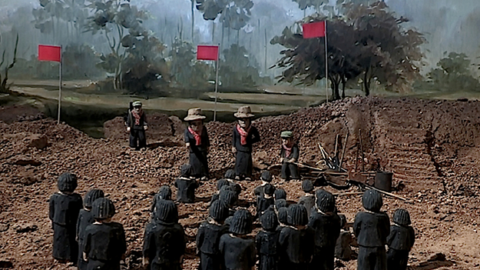Film of the Week: Marlina the Murderer in Four Acts

A popular trick among us film critics is to identify a given film as “really” a Western, wherever in the world it’s set, and particularly if it takes place in the present. It usually requires just a few recognizable genre elements: a stretch of sunbaked landscape, some equally weather-beaten faces, and the odd horse always helps. A second level to this parlor game involves fitting the right national food to the film. By analogy with the “spaghetti Western,” Juzo Itami’s noodle-bar comedy Tampopo kicked off the trend by being marketed as a “ramen Western”—which would make the recent Algerian-set Far from Men a “couscous Western,” Walter Salles’s Behind the Sun (Brazil) a “feijoada Western,” and Valeska Grisebach’s Western a “bratwurst Western.”
Reviewing the Indonesian film Marlina the Murderer in Four Acts, Variety’s Maggie Lee got in promptly with the tag “satay Western”—fair enough, as satay is actually eaten in the film, as is a fatal batch of chicken soup. The spaghetti Western analogy is in any case foregrounded somewhat assertively at the start of the film, as a man on a motorbike pulls up to a lonely farmhouse, somewhere on a deserted plain (the location is the Indonesian island of Sumba). The film’s score, by Zeke Khaseli and Yudhi Arfani, uses some traditional Indonesian elements, but much of it is in that pastiche mode you might call “phony Morricone,” and the music to this opening sequence starts with Mexican-style trumpet and ends with the tolling of a church bell, very redolent of those dead desert towns in Sergio Leone.
Now, church bells are not something you automatically associate with an Indonesian setting—nor are characters with names like Markus, Robert, Franz, and Ian. Director and co-writer Mouly Surya, whose third feature this is—her previous one was 2013’s What They Don’t Talk About When They Talk About Love—is clearly having fun with her genre references here, and Marlina the Murderer certainly aims to provide fun, along with gender provocation of a serious kind.
Written by Surya and Rama Adi, and based on a story by veteran director Garin Nugroho, Marlina the Murderer is essentially a revenge drama in four chapters—named, in English intertitles, “The Robbery,” “The Journey,” “The Confession,” and “The Birth.” Marlina (Indonesian star Marsha Timothy) is at home on her farm one day, her mummified dead husband propped up crouching on the floor—there have been problems with the funeral payments—when a bandit named Markus (Egi Fedly) turns up and tells her that he and his several associates, who are on their way, intend to take her money and her livestock and sleep with her. While he waits for them to arrive, he’s careless enough to insist she cook him some chicken soup, and doesn’t notice when she slips in a lethal ingredient. The gang arrive, tuck into the soup, and drop dead—flopping down in the background of a stunning shot, while Marlina, centrally framed in the foreground, gives a quiet smile of satisfaction.

When Markus attempts to rape her, she decapitates him with a machete. Cue one of the film’s most striking images: Marlina determinedly striding down a country road under blazing sun, carrying Markus’s severed head neatly tied up in a package. She commandeers a passing bus, which happens to be carrying two of the liveliest supporting characters you could wish for. One is a young pregnant woman named Novi, an indefatigably garrulous grumbler, her dialogue delivered by Dea Panendra in a style that’s not so much sing-song as alternately whooping and chirruping. The other is unflappable matron Yohana (Rita Matu Mona), on her way to a family wedding with two horses in tow for dowry; she promptly takes control of the situation, suggesting that maybe Marlina doesn’t really need to keep her machete to the bus driver’s neck (“Isn’t your arm tired, dear?”).
The rape-revenge drama might lay claim to being the popular feminist genre par excellence, if only examples didn’t so often hover with relish over the violence done to its heroines. Surya tends to work by suggestion, however: much of the brutality of Markus and his gang is suggested in their boorish talk in her living room. Entrenched patriarchal attitudes are elsewhere suggested by a policeman who shows little interest as he types up Marlina’s account of events, and by Novi’s boyfriend, who has gotten her pregnant and argues that the delay in her giving birth can only be the result of infidelity, before turning violent on her. Surya tends to keep the violence at a distance from the camera, however, or frame it with distancing formality: Markus’s beheading is done with brisk elegance, in one of those symmetrical shots that are the film’s signature.
Overall, Surya is most interested in her female characters: while most of the gang are faceless generic heavies (the only one to really take stage center after Markus’s death is the rakish young Franz, played by Yoga Pratama), Mouly pays far more attention to Novi, Yohana, and Topan, a young girl at a roadside café who happens to have the same name as Marlina’s dead son. As for Marsha Timothy, the film could hardly go further in making her an iconic figure. Where so many characters in the movie flap around or talk 13 to the dozen, Marlina is a quietly implacable woman of action, whose characteristic expression—often directed straight to camera—is a tersely opaque look of suppressed rage and taciturn dignity. The dialogue is female-skewed, too, especially when Yohana advises Novi that the way to bring on her delivery is through plenty of sex: “It’s like a sauce bottle. You’ve got to poke inside to get it out.”

Marlina the Murderer is visually striking and then some. Surya and DP Yunus Pasolang, shooting in widescreen, favor vast landscapes in which people and vehicles can be seen crawling along ant-size in the far distance: we get endless flat plains, zigzagging hillside paths, huge stretched canopies of sky. Some shots jump out like comic-book images, sometimes because they’re so overtly Leone-esque, like a priceless visual gag in which Markus’s headless body stumbles along the road after the haunted Marlina, plucking a string instrument as he goes.
Interiors at Marlina’s farm, sometimes with a shaft of light diagonally intersecting the room, are shot head-on, with characters arranged carefully like dolls: sometimes, we could be gazing into those little toy rooms from Hereditary. Surya loves symmetry or near-symmetry: as when Marlina sits impassively through a table tennis match, positioned so that she’s at center screen, almost but not quite in line with the net. The film is so highly arranged—Topan and Marlina framed by a window that’s like a little box containing them both—that even Wes Anderson fans might find it a little formal at times.
Surya also goes for long takes and super-measured pacing: the final act is a case of slow-burn cinema taken to a cool extreme. Marlina the Murderer’s death toll is quite substantial and certain images are macabre, yet they feel oddly innocent, or at least without any tinge of the charnel house about them. The mummified husband is just there, silent witness to the home invasion, like an interesting conversation piece that doesn’t much seem to trouble anyone.
Stylish and accomplished as Marlina the Murderer is, its formal detachment left me oddly uninvolved, especially as its constant nods to the Western—not least in the score—can sometimes come across as a little facetious. Nothing in the film speaks as eloquently as Marsha Timothy’s face, her Eastwood-like calm and those quietly angry glares to camera, often from absolute center screen, or just a telling notch away…
Jonathan Romney is a contributing editor to Film Comment and writes its Film of the Week column. He is a member of the London Film Critics Circle.







